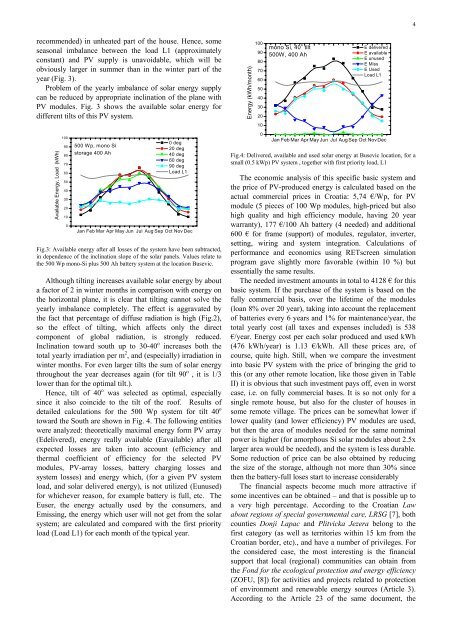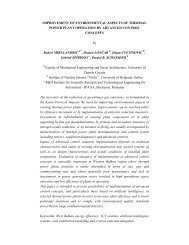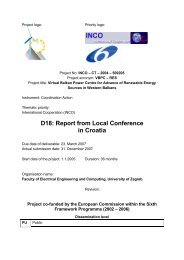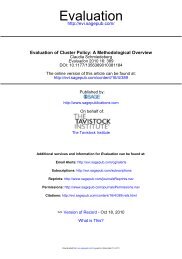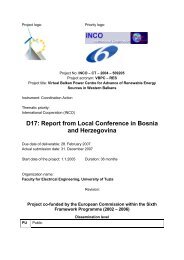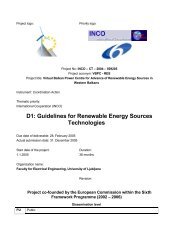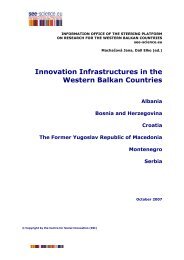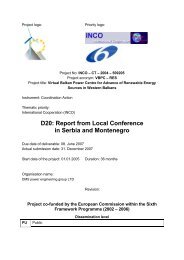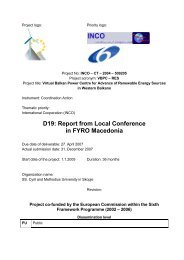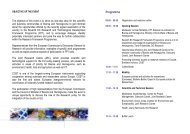Prva stran - WBC-INCO Net
Prva stran - WBC-INCO Net
Prva stran - WBC-INCO Net
Create successful ePaper yourself
Turn your PDF publications into a flip-book with our unique Google optimized e-Paper software.
ecommended) in unheated part of the house. Hence, some<br />
seasonal imbalance between the load L1 (approximately<br />
constant) and PV supply is unavoidable, which will be<br />
obviously larger in summer than in the winter part of the<br />
year (Fig. 3).<br />
Problem of the yearly imbalance of solar energy supply<br />
can be reduced by appropriate inclination of the plane with<br />
PV modules. Fig. 3 shows the available solar energy for<br />
different tilts of this PV system.<br />
Available Energy, Load (kWh)<br />
100<br />
90<br />
80<br />
70<br />
60<br />
50<br />
40<br />
30<br />
20<br />
10<br />
0<br />
500 Wp, mono Si<br />
storage 400 Ah<br />
0 deg<br />
20 deg<br />
40 deg<br />
60 deg<br />
90 deg<br />
Load L1<br />
Jan Feb Mar Apr May Jun Jul Aug Sep Oct Nov Dec<br />
Fig.3: Available energy after all losses of the system have been subtracted,<br />
in dependence of the inclination slope of the solar panels. Values relate to<br />
the 500 Wp mono-Si plus 500 Ah battery system at the location Busevic.<br />
Although tilting increases available solar energy by about<br />
a factor of 2 in winter months in comparison with energy on<br />
the horizontal plane, it is clear that tilting cannot solve the<br />
yearly imbalance completely. The effect is aggravated by<br />
the fact that percentage of diffuse radiation is high (Fig.2),<br />
so the effect of tilting, which affects only the direct<br />
component of global radiation, is strongly reduced.<br />
Inclination toward south up to 30-40 o increases both the<br />
total yearly irradiation per m 2 , and (especially) irradiation in<br />
winter months. For even larger tilts the sum of solar energy<br />
throughout the year decreases again (for tilt 90 o , it is 1/3<br />
lower than for the optimal tilt.).<br />
Hence, tilt of 40 o was selected as optimal, especially<br />
since it also coincide to the tilt of the roof. Results of<br />
detailed calculations for the 500 Wp system for tilt 40 o<br />
toward the South are shown in Fig. 4. The following entities<br />
were analyzed: theoretically maximal energy form PV array<br />
(Edelivered), energy really available (Eavailable) after all<br />
expected losses are taken into account (efficiency and<br />
thermal coefficient of efficiency for the selected PV<br />
modules, PV-array losses, battery charging losses and<br />
system losses) and energy which, (for a given PV system<br />
load, and solar delivered energy), is not utilized (Eunused)<br />
for whichever reason, for example battery is full, etc. The<br />
Euser, the energy actually used by the consumers, and<br />
Emissing, the energy which user will not get from the solar<br />
system; are calculated and compared with the first priority<br />
load (Load L1) for each month of the typical year.<br />
Energy (kWh/month)<br />
100<br />
90<br />
80<br />
70<br />
60<br />
50<br />
40<br />
30<br />
20<br />
10<br />
0<br />
mono Si, 40 o tilt<br />
500W, 400 Ah<br />
E delivered<br />
E available<br />
E unused<br />
E Miss<br />
E Used<br />
Load L1<br />
Jan Feb Mar Apr May Jun Jul Aug Sep Oct NovDec<br />
Fig.4: Delivered, available and used solar energy at Busevic location, for a<br />
small (0.5 kWp) PV system , together with first priority load, L1<br />
The economic analysis of this specific basic system and<br />
the price of PV-produced energy is calculated based on the<br />
actual commercial prices in Croatia: 5,74 €/Wp, for PV<br />
module (5 pieces of 100 Wp modules, high-priced but also<br />
high quality and high efficiency module, having 20 year<br />
warranty), 177 €/100 Ah battery (4 needed) and additional<br />
600 € for frame (support) of modules, regulator, inverter,<br />
setting, wiring and system integration. Calculations of<br />
performance and economics using RETscreen simulation<br />
program gave slightly more favorable (within 10 %) but<br />
essentially the same results.<br />
The needed investment amounts in total to 4128 € for this<br />
basic system. If the purchase of the system is based on the<br />
fully commercial basis, over the lifetime of the modules<br />
(loan 8% over 20 year), taking into account the replacement<br />
of batteries every 6 years and 1% for maintenance/year, the<br />
total yearly cost (all taxes and expenses included) is 538<br />
€/year. Energy cost per each solar produced and used kWh<br />
(476 kWh/year) is 1.13 €/kWh. All these prices are, of<br />
course, quite high. Still, when we compare the investment<br />
into basic PV system with the price of bringing the grid to<br />
this (or any other remote location, like those given in Table<br />
II) it is obvious that such investment pays off, even in worst<br />
case, i.e. on fully commercial bases. It is so not only for a<br />
single remote house, but also for the cluster of houses in<br />
some remote village. The prices can be somewhat lower if<br />
lower quality (and lower efficiency) PV modules are used,<br />
but then the area of modules needed for the same nominal<br />
power is higher (for amorphous Si solar modules about 2.5x<br />
larger area would be needed), and the system is less durable.<br />
Some reduction of price can be also obtained by reducing<br />
the size of the storage, although not more than 30% since<br />
then the battery-full loses start to increase considerably<br />
The financial aspects become much more attractive if<br />
some incentives can be obtained – and that is possible up to<br />
a very high percentage. According to the Croatian Law<br />
about regions of special governmental care, LRSG [7], both<br />
counties Donji Lapac and Plitvicka Jezera belong to the<br />
first category (as well as territories within 15 km from the<br />
Croatian border, etc)., and have a number of privileges. For<br />
the considered case, the most interesting is the financial<br />
support that local (regional) communities can obtain from<br />
the Fond for the ecological protection and energy efficiency<br />
(ZOFU, [8]) for activities and projects related to protection<br />
of environment and renewable energy sources (Article 3).<br />
According to the Article 23 of the same document, the<br />
4


